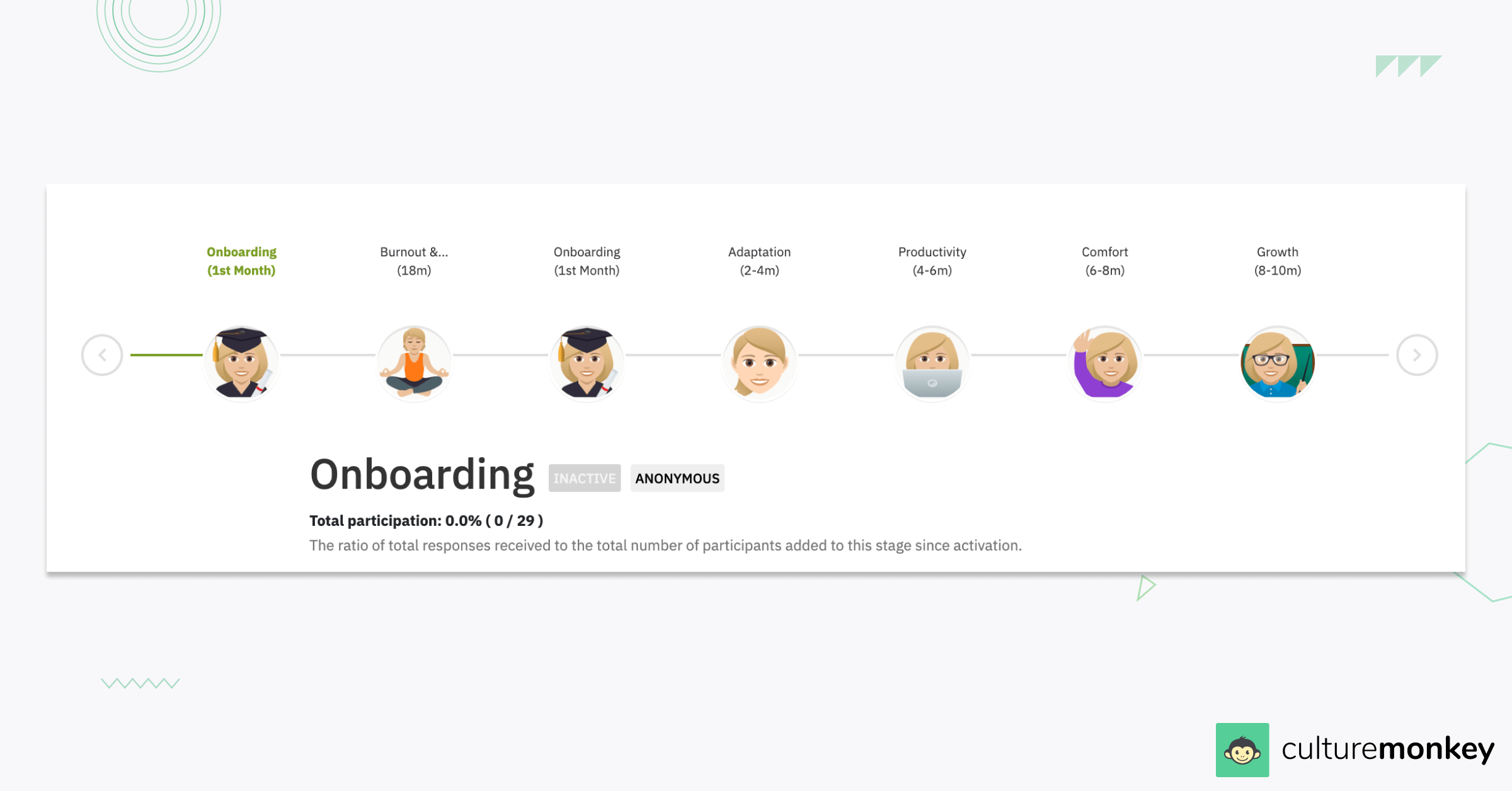30-60-90 Day plan: Onboard new employees like a pro

You've just hired a new employee. Congratulations!
They're eager, excited, and ready to take on their new role. Now what? How do hiring managers ensure that they are properly onboarded so that they can be successful in their new position?
You need a plan that ensures that they hit the ground running and are able to contribute to the company culture in a meaningful way from day one. The first 90 days in 30-60-90 day plan are critical to both the employee as well as the organization.
These 90 days in 30-60-90 day plan determine whether the employee is ready to take on and achieve the organization's objectives and goals along with their new team members.
In order to get a better understanding of what a newly hired employee should achieve and what, as a manager or an HR, you can do to support the employee's career growth, you need a well-defined plan with fixed and flexible milestones.
These milestones are incredibly crucial in the beginning; hence, a 30-60-90 day plan is necessary to guide the employees and track their progress.
Does it seem like a lot? Don't fret! In this blog post, we will explore how to create a 30-60-90 day plan for your new employees, its benefits, and how it can help your business in the long run.
Table of contents :-
- What is a 30-60-90 day plan?
- Benefits of a 30-60-90 day plan
- How to write a 30-60-90 day plan for new hires?
- What is employee onboarding roadmap?
- What are onboarding plans?
- Onboarding objectives
- Significance of onboarding plan for first 90 days
- 11 Important milestones every new hire should accomplish in first 90 days
- What should be included in a 30 60 90 day plan?
- What should new hires accomplish in their first 90 days?
- 30-60-90 Day plan for managers' roles
- What should management do beyond 90 days?
- 30-60-90 day check-in questions to ask onboarding employees
- How to measure onboarding success?
- Getting new hires up to speed quickly
- How can CultureMonkey help with a 30-60-90 day plan for your new hires?
- Conclusion
What is a 30-60-90 day plan?

The essence of a 30-60-90 day plan in onboarding hires for new job.
When you bring on new employees, you want to set them up for future success from the start. The most effective way to do this is to create a 30-60-90-day plan.
A 30-60-90 day plan is a detailed plan that outlines what an employee will do in the first 30, 60, and 90 days in 30-60-90 day plan on the new job, and the plan should be tailored to the specific position and company.
The 30-60-90 day plan in the new job is an effective tool for both new hires and internal hires. It provides a clear framework of expectations and objectives and helps new manager or hires quickly become effective contributors and leaders. It also helps the hiring manager visualize to ensure that new hires are up to speed and able to add value to the team quickly.
The key to a successful 30-60-90 day plan is to be realistic and achievable. Setting realistic, personal goals and objectives that can be accomplished in the allotted time frame is important. It is also important to remember that the plan should be flexible and adaptable to changing circumstances.
The goal of a 30-60-90 day plan is to help an individual transition into a new role within a company. The plan provides guidance and structure during the first three months on the job and sets expectations for what should be accomplished during this time period. It should include the following:
- A breakdown of their daily tasks and responsibilities
- A list of who they need to meet with and when
- A timeline for completing specific projects
- Regular check-ins with you or another supervisor
The milestones for each month in the onboarding stage are different. Here's an example of how you can formulate the milestones for your new hires:
1-30 days
The first month of an employee's time in the organization can be considered their training time. During this learning curve, the employees should be given extensive training to learn about their new team members, company policies, products, team's existing strategy, and work duties.
During the first week, it is important for the hiring managers to ensure the new hire has a smooth onboarding experience by introducing them to the team, providing all necessary paperwork and IT systems, and conducting a full orientation. It is also important to ensure that the new hire understands the company's mission and value and is familiar with the company's key performance metrics.
Within the first two weeks, the new hire should have a clear understanding of their role and responsibilities and the expectations of their manager and the team. This is also a great time to set up regular check-ins from the hiring manager or their direct reports to ensure the new hire is on track and has any resources they need to be successful in their new company.
During the third week, the new hire should have a good understanding of their role and the company's processes and procedures and should be ready to begin contributing to the team. This is a great time to introduce them to external partners and stakeholders and ensure they feel comfortable communicating with their peers and superiors.
By the end of the fourth week, the new hire should be familiar with the company's culture code and be able to work independently. It is important to ensure the new hire has received feedback from their manager, direct reports, and the team and assess their progress and ensure they are meeting their personal learning goals.
By the end of the first 30 days in 30-60-90 day plan, the new hire should be comfortable in their role, and the company's culture and processes and clearly understand their role and responsibilities.
31-60 days
New hires get the chance to apply what they've learned in the first 30 days in 30-60-90 day plan of their employment by taking on challenging duties. Remember, it's acceptable for your direct reports to make mistakes during this crucial learning phase as they become accustomed to the way things are done.
Here are some more milestones to focus on during the 31-60 days in 30-60-90 day plan of employment:
- Start performance reviews: During the 31-60 day period, performance reviews should be conducted to assess the employee’s progress and give them feedback on their work.
- Establish workplace relationships: During this period, the employee should be encouraged to start developing relationships with coworkers, both on their team and outside of their team.
- Set goals: The employee should have a clear understanding of the personal goals for their position and the expectations the company has for them.
- Offer additional training: During this period, employees should be given additional training and resources to help them better understand their role and the company as a whole.
- Assign new responsibilities: As the employee becomes more comfortable in the role, they should be given new responsibilities that challenge them and help them grow.
61-90 days
The final stages or the final 30 days in 30-60-90 day plan is where new hires start mastering the skills they have learned in their job. This means your employee can now fully meet job expectations and start achieving long-term performance goals.
Here are some milestones employers should focus on during the final 30 days:
- Reviewing and reflecting on the employee’s progress: The employee should take some time to review their progress over the past 90 days. This includes looking at their accomplishments, successes, and areas for improvement. This will allow them to understand where they are in their journey and set appropriate company's mission for the future.
- Setting smart goals for the future: Once the employee has reviewed their progress, it’s time to set smart goals for the next 30 days in 30-60-90 day plan. This could include learning a new skill, mastering a certain task, or undertaking a new project.
- Enhancing professional relationships: The last 30 days in 30-60-90 day plan in the new job have been a great time for employees to strengthen their relationships with their colleagues. This could include having lunch with a coworker, offering to help with a project, or joining a professional organization.
- Showing appreciation: It’s important to show appreciation to the people who have helped the employee during their journey. This could include sending thank you cards or emails or offering to help with a project.
- Celebrating successes: The employee should take time to celebrate their successes. This could include going out to lunch with a colleague, taking a day off, or simply taking a moment to recognize their hard work.
Benefits of a 30-60-90 day plan

According to a research by the Brandon Hall Group, an effective and robust onboarding process can boost employee productivity by 70% and retain employees by 82%.
A 30-60-90 day plan is essentially a road map that sets out specific milestones to boost employee productivity during the onboarding phase while improving overall employee engagement and retention.
These milestones are made with a clear understanding of expectations, setting attainable goals, and providing feedback along the way. Organizations can better focus their resources and efforts to achieve their desired goal by having a clear and concise plan.
Here are some of the benefits of having a 30-60-90 day plan for new hires in your organization:
Define success
By having a 30-60-90 day plan in the new job, you can more easily identify and quantify what success looks like in your organization.
It helps to set expectations for both the employer and employee, and gives the employee a structure to work within in order to make a successful transition into the organization.
The plan outlines and helps new employees in learning goals, objectives, and tasks that employees should complete to demonstrate their value to the organization.
It also helps to ensure that the employee’s role is understood and that they have the resources they need to succeed.
By clearly mapping out the expectations of the employee’s role, employers can measure progress and identify areas where additional support or training may be needed.
Set priorities
This plan can help you and your team prioritize tasks and projects. By knowing what needs to be done and when you can better utilize your time and resources.
It also allows the employer to assess the skills and knowledge of the new hire to ensure they are meeting the company’s goals and expectations.
By setting goals and expectations, employers can better manage their resources and ensure that the new hire is meeting their goals and expectations.
With a 30-60-90 day plan, employers can ensure that their new hire is set up to help their team achieve success and is quickly meeting the organization’s goals.
Improve communication
A 30-60-90 day plan in the new job can improve communication between you and your team. By laying out all the tasks and learning goals for the entire organization, everyone will know what needs to be done and when.
The plan provides a framework for setting expectations and goals and helps to ensure that all employees are on the same page.
This plan helps employers define job roles and responsibilities, establish timelines, and create a clear path to success.
It also encourages collaboration and feedback by allowing the employer and the employee to discuss their progress and make adjustments as needed.
So 30-60-90 day plan helps employers to improve communication with their employees, create a better understanding of the company’s expectations, and set the tone for a successful working relationship.
Boost productivity
This type of plan can help boost productivity by ensuring everyone is working towards the same goals. By having a clear plan, you can avoid confusion and wasted time.
It serves as a roadmap for the new hire to follow in the first three months of employment, which is a critical period for any employee.
The plan outlines the objectives that need to be achieved within the first three months, providing clear guidance and direction for the employee. It also allows employers to monitor progress and provide feedback and support when needed.
Additionally, it allows employers to identify any skill gaps and provide appropriate training to ensure employees are able to meet the concrete goals set for them. With a 30-60-90 day plan in place, employers can give their new hires a running start, setting them up for success.
Increase efficiency
A 30-60-90 day plan can help increase efficiency by helping you to utilize your time and resources better.
This plan outlines the personal goals, objectives and tasks that the new hire should accomplish within the first three months of employment.
By setting clear expectations and providing a timeline, new hires can focus on the most important tasks and quickly become effective members of the team.
Improve quality
Leverage a 30-60-90 day plan to improve the quality of your work by ensuring that all tasks are given the proper attention. By avoiding rushed work, you can help to improve the overall quality of your output.
This plan outlines specific activities that new hires should complete within the first three months of their employment, including goal setting, training, and development.
With this plan, employers can ensure that their new hires have the foundational knowledge and resources needed to succeed in their new roles.
Ultimately, this plan helps employers get the most out of their new hires and improve the overall quality of their employee base.
Meet deadlines
New hires can be a great asset to any business, but it can be hard to get them up to speed quickly. A 30-60-90 day plan in the new job helps employers meet their employees' deadlines by providing a framework to help new hires quickly learn their core job responsibilities and how their team operates.
This plan outlines the tasks they must accomplish in the first 30, 60, and 90 days, giving them a roadmap to success.
By taking the time to create a 30-60-90 day plan, employers can ensure new hires are well-prepared to hit the ground running and meet their deadlines.
Reduce stress
An effective 30-60-90 day plan can reduce stress by ensuring that all tasks are given the proper attention. By avoiding unnecessary pressure on the employees, you can help to create a more relaxed environment.
Such plans allow employers to set expectations for new hires in their new company and provide them with the resources and support needed to meet those expectations.
And a 30-60-90 day plan can help employers avoid any surprises that may arise during the onboarding process, allowing them to avoid unnecessary stress.
Improve morale
A 30-60-90 day plan can help improve employee morale. This way, you can create a more positive work environment for your employees in an organization.
This plan helps employers to clearly outline expectations for new hires, provide feedback and guidance, and ensure that the new employee is on track to meet expectations.
By setting up a 30-60-90 day plan, employers can effectively monitor new hires and better understand their strengths and weaknesses.
This will ultimately lead to improved morale and performance, resulting in a more successful organization.
Increase innovation and creativity
A 30-60-90 day plan can foster innovation and creativity within the new hire. By integrating tasks and projects that encourage creative thinking and problem-solving, the plan becomes a catalyst for fresh ideas.
This not only contributes to the employee's professional growth but also infuses new perspectives into the organizational culture, enhancing overall creativity.
Enhance employee engagement
Employee engagement is a cornerstone of organizational success. Incorporating engagement initiatives within the 30-60-90 day plan, such as team-building activities or mentorship programs, creates a positive work environment.
Increased engagement not only improves job satisfaction but also nurtures a sense of commitment and loyalty from the new hire towards the organization.
Encourage proactive learning
A dynamic onboarding plan encourages a proactive approach to learning internal processes. By instilling a mindset of continuous improvement and adaptability, employees are motivated to seek out opportunities for self-development.
This proactive learning approach ensures that the new hire not only meets the immediate goals outlined in the plan but also becomes a lifelong learner, contributing to their long-term success within the company.
Build a strong foundation for career growth
A well-structured 30-60-90 day plan provides new hires with a clear understanding of their career path and growth opportunities within the organization. By setting short-term goals that align with long-term career aspirations, employees can see a direct connection between their initial tasks and their future success, motivating them to strive for excellence.
This foundation helps employees understand how their contributions impact the organization’s success, fostering a sense of purpose and direction. Additionally, by identifying potential areas for development early on, employers can provide targeted training and support, ensuring that employees are well-equipped to advance their careers within the company.
Strengthen organizational culture
By integrating cultural values and principles into the 30-60-90 day plan, employers can ensure that new hires quickly adapt to the company’s ethos. This alignment helps to strengthen the organizational culture, as new employees internalize and embody the values that drive the company’s mission and vision.
Through consistent reinforcement of these values during the onboarding process, new hires are more likely to develop a strong connection to the company culture, fostering a sense of belonging and loyalty. This approach promotes a unified organizational identity, where all employees, regardless of tenure, share a common understanding of the company’s core values and goals.
How to write a 30-60-90 day plan for new hires?

Follow these detailed steps to write an effective 30-60-90 day plan for your new hires:
Step 1: Brainstorm onboarding questions
During the first week, ensuring a smooth onboarding process is key to creating a good impression of the organization with the employee. A good onboarding can help employees feel welcome and comfortable in their new position.
To ensure you provide the new hires with effective onboarding, it is imperative to recognize their skills, required learning curve and understand where precisely in the organization they fit well.
Begin the process by brainstorming with survey questions that assess an employee’s ability and critical skills. For example:
- What are the skills the employee should possess to fulfil his role successfully?
- What problems are you trying to solve? Or what gap are you trying to fill with the new hire?
- What can be their day-to-day responsibilities?
You can even utilize onboarding survey questions to help you get insights on the employee’s experience, expectations from the role and the organization, personal goals, and more.
Step 2: Set your expectations
Once you figure out the answers in the form of employee feedback to your brainstorming or onboarding survey questions, you will have a better idea of what you would want your new hires to learn and achieve in the first 90 days. Not overloading your employees with too many goals and objectives is important.
This can only confuse them and overload them, leading to dissatisfaction and an unbalanced in professional and personal level. Prepare your 30-60-90 day plan with more straightforward performance goals that don’t overwhelm your new employees.
Step 3: Leverage measurable goals
Did you know that 29% of employees believe that proper onboarding prepares them for their job better? A good onboarding with practical and clearly defined concrete goals in a 30-60-90 day plan can help employees achieve their feasible performance goals faster as this provides them with clarity.
But if the employees misunderstand these smart goals, the expected results cannot be attained. Hence, you should always adopt SMART feasible performance goals.
S - Specific
M - Measurable
A - Attainable
R - Realistic
T - Time-bound
When your expectations follow the SMART rule, then employees have much better clarity on their concrete goals.
For example, all employees must complete a two-week training on the company systems and processes (time-bound, specific, and attainable) and should be able to perform their work tasks successfully using the same systems and processes.
Step 4: Use a buddy system
Many organizations use a buddy or mentor program to assist their new hires in the first few months of their time in the organization. Simply creating a 30-60-90 day plan and handing them over to the new employees expecting them to learn and understand everything on their own competitive research, is unrealistic.
While you prepare the 30-60-90 day plan for your employees, ensure you assign them a buddy or mentor. The buddy will be their go-to person for any guidance they need in the first few weeks. It will also help them feel less overwhelmed in a new work environment with unfamiliar people.
Step 5: Check-in regularly
While you write a 30-60-90 day plan, it is crucial to understand that what the employee accomplishes in the first 90 days is key to the growth of the employee in the organization. However, it should be flexible.
Certain circumstances in a dynamic work environment would require the new hire to work on different tasks than what was mentioned on the 30-60-90 day plan.
Check in regularly on the milestones achieved and the current tasks of the employee in the first few weeks to modify the plan based on the changes if needed.
What is employee onboarding roadmap?
Imagine the employee onboarding roadmap as your company's personalized GPS guiding new team members through the exciting journey of integration. It's not just a set of directions; it's the key to a smooth and engaging onboarding experience.
At its core, the onboarding roadmap is a step-by-step guide that ensures new hires hit the ground running. From the initial orientation that unveils the company's culture and values to the strategic training modules tailored to their role, each milestone is a carefully plotted destination on this roadmap.
This dynamic guide doesn't just stop at the first week – it extends well into the first 90 days and beyond. It's the route that helps new employees navigate the twists and turns of their roles, providing ongoing support, feedback loops, and opportunities for growth.
Think of it as a dynamic map, adjusting and evolving to ensure each new team member finds their way to success within the organization.
What are onboarding plans?

Onboarding plans are meticulously crafted frameworks designed to facilitate the seamless integration of new hires into an organization. This structured process ensures that employees are not only acquainted with their roles but also acclimated to the company's culture, values, and operational procedures.
Here's a step-by-step breakdown of a comprehensive onboarding plan:
- Pre-arrival preparation: Commence the onboarding process even before the new hire walks through the door. Share pertinent information about the organization, the team, and the initial tasks to set expectations.
- Administrative essentials: Streamline administrative processes. Ensure swift completion of paperwork, provisioning of necessary employee engagement survey tools, and facilitation of access to essential systems, minimizing delays and administrative burdens.
- Role clarification: Clearly articulate the new hire's role and responsibilities. Define performance expectations, key performance indicators (KPIs), and milestones, establishing a roadmap for success.
- Training: Facilitate targeted training programs. Tailor these programs to the specific requirements of the role, providing the necessary skills and knowledge for effective job performance.
- Team integration: Encourage team building and collaboration. Facilitate introductions with team members and key stakeholders, fostering an environment of inclusion and camaraderie.
- Ongoing support and feedback: Provide continuous support. Establish regular check-ins and feedback sessions to address concerns, offer guidance, and gauge the new hire's comfort and progress.
- Long-term integration: Extend the onboarding plan beyond the initial weeks. Develop long-term integration strategies, including mentorship programs, professional development initiatives, and opportunities for career growth, ensuring sustained success within the organization.
Onboarding objectives

Embarking on the onboarding process is akin to laying the foundation for a lasting professional relationship. To ensure a seamless integration of new team members, meticulous attention to onboarding objectives is paramount. Here are eleven key points to consider:
- Clarify expectations: Establish clear expectations from the outset. Outline roles, responsibilities, and performance benchmarks to provide a comprehensive understanding of the new hire's mission within the organization.
- Accelerate adaptation: Facilitate a swift assimilation into the company culture. A well-structured introduction to the organizational ethos, values, and norms fosters a sense of belonging and commitment.
- Equip with knowledge: Immerse the new team member in a comprehensive understanding of company operations. Provide in-depth training on tools, technologies, and processes essential for seamless daily functioning.
- Foster interdepartmental connectivity: Promote cross-functional collaboration by encouraging interactions with colleagues from various departments. This not only broadens the new hire's perspective but also establishes valuable networking channels.
- Ensure compliance and ethical awareness: Prioritize legal and ethical compliance education. Equipping new hires with an understanding of company policies, industry regulations, and ethical standards sets the groundwork for responsible conduct within the organization.
- Individualized development plans: Craft personalized development plans tailored to the specific needs and aspirations of each team member. This bespoke approach ensures that their professional growth aligns harmoniously with organizational objectives.
- Continuous feedback mechanism: Implement a robust feedback system. Regular check-ins and performance reviews provide opportunities for constructive criticism, acknowledgment of achievements, and the alignment of individual goals with organizational objectives.
- Technology integration: Leverage technology to streamline onboarding processes. Incorporate digital platforms for efficient document management, task tracking, and communication, ensuring a technologically adept workforce.
- Establish mentorship programs: Instigate mentorship initiatives to guide new hires through their initial phases. An experienced mentor can offer insights, advice, and a supportive environment for acclimatization.
- Measure onboarding success metrics: Define and measure key performance indicators (KPIs) to evaluate the success of the onboarding process. Metrics such as time to productivity, retention rates, and employee satisfaction provide invaluable insights into the efficacy of the program.
- Post-onboarding support: Extend support beyond the initial onboarding phase. Continued mentorship, access to professional development resources, and opportunities for advancement contribute to the sustained success and loyalty of team members.
Significance of onboarding plan for first 90 days

The significance of a well-structured onboarding plan during the first 90 days of an employee's tenure cannot be overstated. This critical period lays the foundation for their integration into the organizational ecosystem, shaping their perception, productivity, and long-term commitment.
An effective onboarding plan serves as a structured roadmap, guiding new hires through the intricacies of the company's culture, values, and operational processes. It facilitates a seamless assimilation, helping individuals understand their roles and responsibilities within the larger framework of the organization.
Moreover, during the initial 90 days, employees are in a state of heightened receptivity and adaptation. An onboarding plan, meticulously designed to introduce them to the company's mission, vision, and goals, harnesses this receptivity to instill a sense of purpose and alignment with the organizational objectives.
Beyond mere orientation, a well-crafted onboarding plan contributes significantly to employee engagement and retention. By addressing the specific needs of new hires, providing the necessary resources, and fostering early connections with colleagues and mentors, organizations cultivate a positive work environment that encourages commitment and loyalty.
Furthermore, the first 90 days represent a crucial period for skill development and proficiency acquisition. An onboarding plan that includes comprehensive training modules, mentorship initiatives, and continuous feedback mechanisms ensures that new hires not only understand their roles but also acquire the essential skills to excel in them.
11 Important milestones every new hire should accomplish in first 90 days

Different organizations have different milestones set as a part of their 30-60-90 day plans for their new hires.
However, there are certain basic accomplishments every employee should aim to achieve in the first three months that should be a part of the overall plan you prepare, and here they are:
1. Complete onboarding and paperwork
Onboarding and paperwork is essential to ensure that new manager or hires understand the company mission, policies and procedures, as well as the company's expectations of them.
Completing these forms within the first 90 days of employment allows new hires to get up to speed quickly.
This is beneficial for both the new hire and the company, as it ensures the new hire is well-informed and productive and that the company is compliant with all necessary regulations.
2. Attend all required training sessions
Attending all required training sessions gives new hires the knowledge and skills they need to perform their job duties and responsibilities.
This initial training also helps them become familiar with the company’s culture, values, and policies.
Training sessions can also provide new hires with valuable networking opportunities, where they can meet and interact with their colleagues and other professionals in their field.
By attending all required training sessions, new hires can learn the information that they need to become successful in their role, while also building relationships with their colleagues.
3. Get to know their co-workers and develop relationships
Developing relationships with co-workers also allows for open communication, which can help to identify any areas where the new hire may need additional support or guidance.
Building relationships also helps to create a sense of trust and respect among team members, and understanding of own team's processes and team's work style which can lead to better collaboration and an overall more positive work environment.
Getting to know their co-workers and developing relationships within their first 90 days on the job is essential for new hires to be successful in their roles.
4. Understand their job description and responsibilities
New hires should understand their job description and responsibilities within the first 90 days to ensure that they are able to effectively and efficiently contribute to their organization.
Understanding job responsibilities will help new hires to confidently work with their team, gain a better understanding of their job, and become more productive in their role.
Furthermore, it can also help new hires to identify areas of improvement and develop their skills to further benefit the organization.
5. Gain a clear understanding of the company's culture, values, and mission
Gaining a clear understanding of the company's culture, values, and mission within the first 90 days of a new hire is essential to their success.
Knowing the company's culture and values can help new hire make better decisions, understand how their job fits into the company’s larger goals, and build relationships with their colleagues.
Being aware of the company's culture, values, and mission will also help the new hire to better align themselves with the company, leading to greater job satisfaction and better performance.
6. Meet with their supervisor to discuss company's mission objectives
The meeting provides a great opportunity for both the supervisor and the new hire to get to know each other and build a trusting working relationship.
It also allows the supervisor to provide the new hire with important information and resources, discuss any challenges or obstacles they may face, and set clear expectations for successful performance.
7. Begin to develop a plan for their career development
Developing a plan for career development within the first 90 days of being hired is essential for long-term career success.
It allows the new employee to have a clear understanding of the career path they want to pursue within the organization and provides them with the knowledge and resources to progress in their chosen field.
Moreover, it enables the new hire to identify and set performance goals, enabling them to take ownership of their career and make the most of their time within the organization.
Additionally, having such a plan provides the new hire with the flexibility to adjust and make changes as needed, while still remaining focused on their development and achieving their career goals.
Ultimately, having a plan for career development in the first 90 days in 30-60-90 day plan of being hired is critical for the long-term team success of the new hire.
8. Participate in cross-functional activities
Engaging in cross-functional activities expands the new hire's understanding of the organization.
By participating in projects or initiatives that involve collaboration across different departments, employees gain insights into diverse perspectives, fostering a more comprehensive view of the company's operations and goals.
9. Contribute to a team project
Actively contributing to a team project within the first 90 days demonstrates the new hire's commitment to teamwork and collective success.
This milestone allows individuals to showcase their skills, collaborate with colleagues, and contribute meaningfully to the organization's objectives.
10. Seek feedback from peers and supervisors
Initiating conversations to seek feedback from both peers and supervisors is a crucial aspect of professional growth.
Understanding areas of strength and areas for improvement early on empowers new hires to adapt and excel. Constructive feedback also facilitates a smoother integration into the team and the organizational culture.
11. Participate in professional development opportunities
Actively participating in professional development opportunities during the first 90 days underscores a commitment to continuous learning.
Whether through workshops, seminars, or online courses, investing in personal and professional growth enhances the new hire's skills and contributes to their long-term success within the organization.
What should be included in a 30 60 90 day plan?

A well-thought-out 30-60-90 day plan serves as a compass, guiding an employee through the crucial first months of their tenure. Here are seven key components that should be included in a comprehensive 30-60-90 day plan:
First 30 days: Orientation and immersion
The initial 30 days are pivotal for acclimating to the organizational landscape. Start by immersing yourself in the company's culture, values, and mission. Attend orientation sessions, engage with key stakeholders, and absorb the nuances of the workplace environment.
Establish a solid understanding of your role, responsibilities, and the broader team dynamics.
Days 30-60: Skill development and contribution
With the foundation laid in the first month, focus on honing the specific skills required for your role. Identify training opportunities, attend relevant workshops, and familiarize yourself with internal processes and tools.
Begin actively contributing to team projects, demonstrating your capabilities and integrating seamlessly into the workflow. Seek feedback to refine your approach and ensure alignment with organizational expectations.
Days 60-90: Strategic planning and leadership engagement
As you progress into the third month, shift your focus towards strategic planning and leadership engagement. Delve deeper into long-term projects, contributing ideas and solutions that align with the company's objectives.
Cultivate relationships with key decision-makers and stakeholders, demonstrating your commitment to the organization's success. Explore opportunities to lead or participate in initiatives that showcase your leadership potential.
Set clear goals and objectives
Each phase of the plan should be guided by clear, measurable goals and objectives. Define what success looks like at the end of each 30-day interval.
Whether it's mastering a specific skill, successfully completing a project, or forging key relationships, having well-defined goals provides direction and purpose.
Demonstrate adaptability and learning agility
Incorporate a focus on adaptability and learning agility into each phase of your plan. Highlight your ability to quickly grasp new concepts, navigate challenges, and apply feedback. Showcase a willingness to evolve and adapt to the evolving needs of the organization.
Communicate effectively
Effective communication is a cornerstone of a successful 30-60-90 day plan. Regularly update key stakeholders on your progress, challenges, and achievements.
Seek feedback proactively and use communication as a tool to demonstrate your engagement, commitment, and value to the team.
What should new hires accomplish in their first 90 days?

The first 90 days for new hires serve as a critical window for establishing a strong professional foothold. To ensure a fruitful onboarding experience, new hires should focus on accomplishing key milestones within this timeframe.
- Establish a strong foundation: The initial days are dedicated to laying a robust foundation. New hires should diligently familiarize themselves with the company's mission, vision, and core values. Understanding the organizational culture is paramount, as it forms the basis for effective collaboration and alignment with corporate goals.
- Build relationships: Forge meaningful connections with colleagues, fellow team members, and key stakeholders. Cultivating professional relationships fosters a collaborative work environment and provides valuable support networks. Engage in open communication, actively seek feedback, and showcase a commitment to teamwork.
- Master core responsibilities: Within the first 30 days, new hires should aim to master their core responsibilities. Acquiring proficiency in essential tasks demonstrates competence and contributes to the team's overall efficiency. Seek guidance from mentors or supervisors to ensure a comprehensive understanding of job requirements.
- Initiate continuous learning: The second phase, spanning days 30 to 60, should be dedicated to continuous learning. Identify areas for skill development and proactively engage in training programs or workshops. Demonstrating a commitment to ongoing learning not only enhances individual capabilities but also contributes to the organization's growth.
- Contribute actively to projects: Transitioning into the third month, new hires should actively contribute to team projects. Whether large or small, involvement in projects showcases initiative and a willingness to apply newfound knowledge to practical scenarios. This stage is critical for demonstrating value and integration into the team's workflow.
- Align with organizational goals: By the end of the first 90 days, new hires should aim to align their individual goals with the broader objectives of the organization. Understanding how their role contributes to the company's success fosters a sense of purpose and ensures a seamless integration into the organizational framework.
30-60-90 Day plan for managers' roles

For managers stepping into new roles, the first 90 days are a critical period that demands a strategic and focused approach. Crafting a well-structured 30-60-90 day plan is essential for success in managerial positions. Here's a guide for managers to navigate each phase:
First 30 days: Orientation and immersion
In the initial 30 days, managers should prioritize orientation and immersion. Familiarize yourself with the company's culture, values, and operational structure.
Establish connections with key stakeholders, team members, and other departments to gain a holistic understanding of the organization.
Days 30-60: Strategic planning and relationship building
As you transition into days 30 to 60, shift your focus towards strategic planning and relationship building. Dive deeper into team dynamics, identify strengths and areas for improvement, and initiate strategic planning sessions.
Establish clear lines of communication and build relationships with your team, fostering a collaborative and cohesive work environment.
Days 60-90: Execution and continuous improvement
In the final phase, days 60 to 90, it's time to execute the strategic plans developed and focus on continuous improvement. Implement changes, address challenges, and actively lead your team towards achieving organizational goals.
Regularly solicit feedback from team members and stakeholders to fine-tune strategies and ensure alignment with overarching objectives.
And,
- Effective communication strategies: Prioritize effective communication strategies. Establish open lines of communication with your team, ensuring that expectations are clear, feedback is constructive, and information flows seamlessly within the team and across departments.
- Align team goals with organizational objectives: Ensure that the goals set for your team align seamlessly with the broader organizational objectives. Communicate the significance of each team member's role in contributing to the company's success, fostering a shared sense of purpose.
- Adaptability and problem solving: Demonstrate adaptability and effective problem-solving skills. In a managerial role, the ability to navigate unforeseen challenges and adapt strategies to changing circumstances is crucial. Showcase your problem-solving prowess to instill confidence in your team.
- Cultivate leadership presence: Cultivate a strong leadership presence. Inspire and motivate your team through your actions and words. Showcase the qualities of a leader – decisiveness, integrity, and a commitment to excellence.
- Employee engagement strategies: Implement employee engagement strategies. Foster a positive and inclusive work environment, where team members feel valued and motivated to contribute their best efforts.
- Succession planning: Initiate succession planning. Identify and nurture potential leaders within your team, creating a pipeline of talent that ensures continuity and stability in the face of organizational changes.
What should management do beyond 90 days?

The initial 90 days for new hires mark a crucial period of adjustment and integration into the organizational structure.
However, the journey doesn't end there. To ensure sustained success and foster a thriving work environment, management plays a pivotal role beyond the first 90 days. Here are ten essential steps management should take:
- Ongoing feedback and evaluation: Implement a continuous feedback system. Regular performance evaluations and constructive feedback sessions provide valuable insights into the new hire's progress, allowing for adjustments and improvements as needed.
- Professional development initiatives: Invest in ongoing professional development. Identify opportunities for skill enhancement and career growth, providing resources, mentorship, and training programs that align with the employee's long-term goals.
- Clear career path discussions: Engage in transparent discussions about the new hire's career path within the organization. Define potential growth trajectories, milestones, and opportunities for advancement, ensuring alignment with both individual aspirations and organizational needs.
- Regular check-ins and communication: Maintain regular communication. Scheduled check-ins and open lines of communication demonstrate management's commitment to the new hire's well-being, ensuring that any concerns or challenges are addressed promptly.
- Alignment with organizational goals: Reiterate the connection between individual roles and organizational objectives. Ensuring that each employee understands how their work contributes to the company's overall success fosters a sense of purpose and commitment.
- Feedback from team members: Seek feedback from colleagues. Input from team members provides a holistic perspective on the new hire's performance and integration, identifying areas for improvement and recognizing positive contributions.
- Recognition in team settings: Promote public recognition within team settings. Team meetings, newsletters, or other internal communication channels can be utilized to highlight individual achievements, fostering a sense of belonging and camaraderie.
- Encourage innovation and initiative: Empower new hires to bring fresh ideas to the table. Encourage innovation and initiative, creating an environment where employees feel comfortable expressing their creativity and contributing to the organization's growth.
- Adaptability and flexibility: Recognize the importance of adaptability. The workplace is dynamic, and management should support new hires in adapting to changes, evolving responsibilities, and emerging opportunities.
- Employee surveys and feedback sessions: Conduct employee surveys and feedback sessions. Gathering insights about job satisfaction, work environment, and overall experiences helps identify areas for improvement and ensures the organization remains responsive to employee needs.
30-60-90 day check-in questions to ask onboarding employees
The first 90 days can be a rollercoaster of emotions, challenges, and triumphs, so why not steer the ship with a well-crafted set of check-in 30/60/90 day employee survey questions? Let's dive into the 30 questions that will make your onboarding process a smooth sail:
The first 30 days:
- How's your onboarding experience been so far?
- What aspects of our company culture have stood out to you in these initial weeks?
- Are there any tools or resources you feel you need more guidance on?
- What goals have you set for yourself in your first month, and how can we support you in achieving them?
- Have you had the chance to connect with your team members? What's been the highlight of those interactions?
Days 30-60:
- How do you feel your role aligns with the company's overall mission and vision?
- What projects or tasks have you found most challenging, and what strategies have you used to overcome them?
- Are there any training modules or workshops you think could enhance your skills and contributions?
- In what ways have you incorporated feedback into your daily work?
- Have you identified any areas where you see opportunities for improvement in our processes?
Days 60-90:
- How would you describe your integration into the team so far?
- What achievements are you most proud of in the past 60 days?
- Are there specific aspects of your role that you'd like to explore further or delve deeper into?
- What suggestions do you have for enhancing team collaboration and communication?
- How can we support your professional development in the coming months?
Reflecting on the journey:
- What surprises or unexpected discoveries have you encountered during your onboarding journey?
- How do you envision your role evolving in the next 90 days?
- What feedback do you have regarding our onboarding process and how we can refine it for future hires?
- How have your expectations about the company evolved since your first day?
- If you could change one thing about your onboarding experience, what would it be?
Looking forward:
- What are your goals for the next quarter, both professionally and personally?
- How can we ensure that you continue to feel challenged and engaged in your role?
- What support or resources do you believe would accelerate your growth within the company?
- In what ways do you see yourself contributing to the success of your team and the organization as a whole?
- What advice would you give to future employees going through the onboarding process?
Final stretch:
- What has been the highlight of your onboarding journey, and why?
- How can we celebrate your achievements as part of the team?
- What areas do you believe you've made the most significant impact in so far?
- Do you have any lingering questions or uncertainties about your role or the company as a whole?
- As you look back on your first 90 days, what words would you use to describe your experience?
How to measure onboarding success?
Measuring onboarding success is crucial for ensuring new hires integrate smoothly into the organization and become productive members of the team. Here are key metrics and methods to effectively gauge the success of your onboarding process:
- Time to productivity: Measure how quickly new hires reach full productivity. This involves tracking the time taken for new employees to complete their training and begin performing their roles effectively. Shorter time to productivity indicates a more efficient onboarding process.
- Employee retention rates: Evaluate the retention rates of new hires within their first year. High retention rates suggest that the onboarding process successfully integrates employees into the company culture and their roles, reducing turnover.
- New hire performance metrics: Assess the performance of new hires against set benchmarks and goals. Regular performance reviews during the first 90 days can provide insights into how well the onboarding process prepares employees for their responsibilities.
- Feedback surveys: Conduct surveys with new hires to gather feedback on their onboarding experience. Questions should cover aspects such as clarity of training, support received, and overall satisfaction. This feedback is invaluable for identifying areas of improvement.
- Manager assessments: Involve managers in evaluating the onboarding process. Their perspective on the readiness and performance of new hires can highlight strengths and weaknesses in the onboarding program.
- Cultural fit and engagement: Measure how well new hires assimilate into the company culture and engage with their teams. Indicators such as participation in team activities and alignment with company values can provide insights into the onboarding process’s effectiveness.
- Training completion rates: Track the completion rates of onboarding training modules. High completion rates suggest that new hires are engaged and the training content is accessible and relevant.
- Cost of onboarding: Analyze the costs associated with the onboarding process compared to the benefits, such as increased productivity and reduced turnover. A cost-effective onboarding process that yields positive outcomes is a good indicator of success.
Getting new hires up to speed quickly
Accelerating the onboarding process to get new hires up to speed swiftly is imperative for organizational efficiency and employee engagement. A structured and efficient onboarding program is key to achieving this objective.
Firstly, a well-defined onboarding process is essential. Providing new hires with comprehensive information about the company's culture, values, and mission sets the tone for their integration. This initial understanding fosters a sense of belonging and aligns the individual with the broader organizational goals.
Secondly, streamlining administrative tasks is crucial. Automating paperwork, access requests, and other procedural aspects accelerates the onboarding timeline, allowing employees to focus on their core responsibilities from day one. This not only expedites their productivity but also minimizes potential frustration associated with administrative delays.
Additionally, offering targeted training programs tailored to the specific requirements of the role ensures that new hires acquire the necessary skills swiftly. By providing access to relevant resources, mentorship opportunities, and ongoing support, organizations can expedite the learning curve and empower employees to contribute meaningfully to team objectives.
How can CultureMonkey help with a 30-60-90 day plan for your new hires?

Employee life cycle module to help you with 30-60-90 day plan of your new job and hires
An employee’s life cycle in an organization can be divided into different segments or stages in between onboarding to exit.
Each stage is critical for an organization to amplify overall employee engagement and reduce turnover costs.
But how do you measure and track employee engagement over all these stages?
The onboarding phase creates the first impression of the organization with the employee. To understand what can be done better, you have to analyze each and every employee’s experience with their onboarding stage. Now, this may sound like a tedious process if done manually.
CultureMonkey automates this process to get measurable results from your employees from time to time through employee life cycle surveys.
With CultureMonkey’s employee life cycle surveys, you can create improved 30-60-90 day plans by tapping into essential data from the employees to measure success and own performance metrics, such as their feedback on the interview process, expectations from the organization, personal and professional goals, and many more.
These insights can also help improve the overall recruitment process for future employees.
Unlike general employee engagement survey tools, CultureMonkey schedules and sends employee surveys based on employee segments, such as generation, tenure, pay band, role type, gender, and location base.
The data received through these surveys helps an organization get a better hold on ways to improve employee engagement and boost employee retention. This data can be used to create a tailored 30-60-90-day plan for each new hire.
Conclusion
Following a 30-60-90 day plan can help organizations onboard new employees like a pro. By taking the time to clearly outline expectations and goals for the first three months on the job, you will give them everything they need to hit the ground running and be an asset to your team.
Furthermore, regular check-ins and implementing anonymous feedback during this period can help ensure everyone is on the same page and identify areas where additional support may be needed.
FAQs
1. What should new hires accomplish in their first 90 days?
In their first 90 days, new hires should focus on understanding their role and responsibilities, integrating into the company culture, building relationships with team members, and achieving initial performance goals. They should complete onboarding training, begin contributing to projects, and seek feedback regularly. Establishing a clear understanding of expectations and demonstrating early productivity are key accomplishments in this critical period.
2. When to make a 30 60 90 day plan?
A 30-60-90 day plan should be created before the new hire’s start date, ideally during the final stages of the hiring process. This preparation ensures a smooth transition and provides the new employee with a clear roadmap from day one. Early planning allows for alignment with organizational goals and tailored support to meet the specific needs of the new hire.
3. How does a 30 60 90 onboarding plan benefit new hires?
A 30-60-90 onboarding plan benefits new hires by providing clear expectations, structured goals, and a timeline for achieving key milestones. This roadmap helps new employees acclimate to their roles, enhances productivity, and reduces anxiety by offering guidance and support. It fosters engagement, improves communication, and ensures a smoother transition into the company, ultimately contributing to long-term success and retention.
4. What role does feedback play in a 30 60 90 onboarding plan?
Feedback plays a crucial role in a 30-60-90 onboarding plan by offering new hires insights into their performance, areas for improvement, and achievements. Regular feedback sessions help new employees adjust their strategies, align with organizational expectations, and stay motivated. Constructive feedback fosters growth, enhances learning, and ensures that new hires receive the support they need to succeed and integrate smoothly into the team.
5. What milestones should be set for the 60-day mark?
At the 60-day mark, milestones should include achieving proficiency in core job responsibilities, completing key training sessions, and starting to contribute significantly to team projects. New hires should have built initial relationships with colleagues, begun integrating into the company culture, and demonstrated understanding of company policies and procedures. Additionally, they should be prepared to set goals for further development and productivity enhancements.



